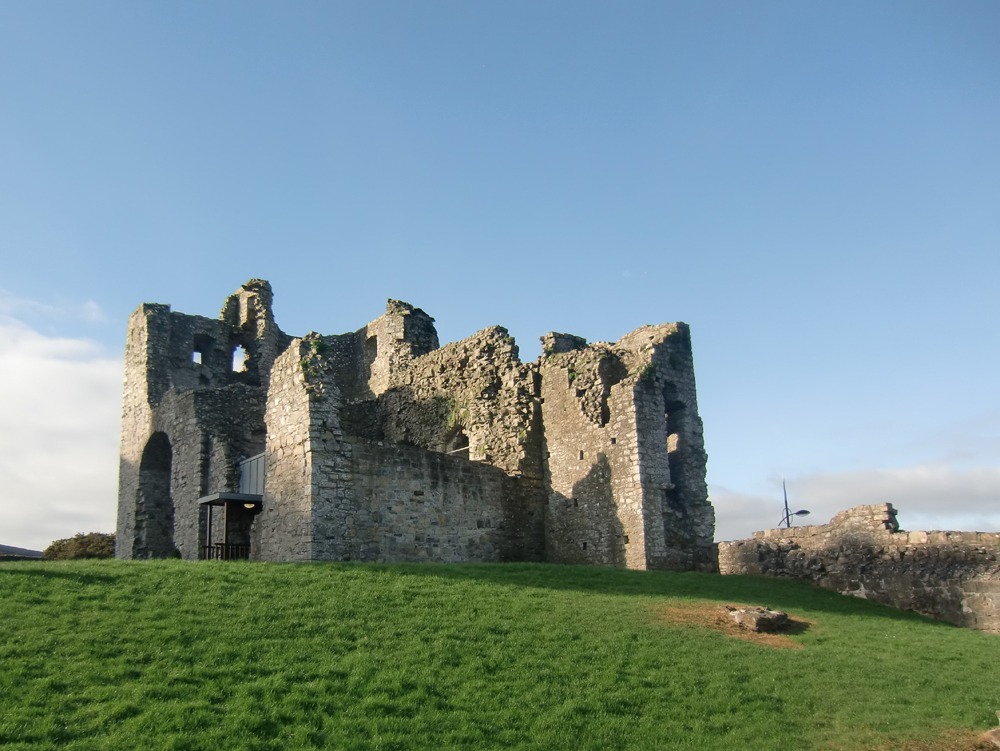FEBRUARY 25
Trim Castle***Newgrange***Monasterboice***Hill of Tara
TRIM CASTLE (Irish: Caisleán Bhaile Atha Troim), our first destination in County Meath is on the bank of the Boyne. It was the largest Anglo-Norman castle built primarily by Hugh de Lacy and his son Walter from 1172 to 1224. Lord Dunsany, the last owner, held the Castle and surrounds until 1993 and sold the land and buildings to the State, retaining only river access and fishing rights. The Castle is noted for the part it played in the filming of the film
Braveheart directed by Mel Gibson.
Next on the tour is a UNESCO World Heritage Site,
NEWGRANGE (Irish:
Sí an Bhrú), a prehistoric monument built around 3200 BC, during the Neolithic period. The site's use is speculated to be of some form of religious significance because it is aligned with the rising sun, which floods the stone room with light on the winter solstice. Newgrange is older than Stonehenge and the great pyramids of Giza. Newgrange contains various examples of abstract Neolithic rock art, the most notable is on the entrance stone which has been described as "one of the most famous stones in the entire repertory of megalithic art. Tours begin at the Brú na Bóinne Visitor Centre from which visitors are bussed to the site in groups.
The entrance now and the overgrown entrance in 1905.
We next went to the historic ruins of
MONASTERBOICE (Irish:
Mainistir Bhuithe), an early Christian settlement in County Louth which was founded in the late 5th century by Saint Buithe who died around 521. The site houses two churches built in the 14th century or later and an earlier round tower, but it is most famous for its 10th century high crosses.
The three high crosses: the
South Cross (Muiredach's High Cross), the
West Cross or the Tall Cross, and the enclosed
North Cross.
Details of the
Muiredach's High Cross, named after Abbot Muiredach mac Domhnaill, who died in 923, feature biblical carvings of both the Old and New Testaments and is regarded as the finest high cross in the whole of Ireland.
Monasterboice's
Round Tower.
The
HILL OF TARA (Irish:
Cnoc na Teamhrach, Teamhair or Teamhair na Rí), located near the River Boyne, is an archaeological complex that runs between Navan and Dunshaughlin in County Meath. It contains a number of ancient monuments, and, according to tradition, was the seat of the High King of Ireland, including a standing stone, which is believed to be the
Lia Fáil (Stone of Destiny) at which the High Kings were crowned. According to legend on the inauguration of a worthy high king the stone would roar its approval.
The
Mound of the Hostages (Irish:
Dumha na nGiall) is a small Neolithic passage tomb built between 2500 and 3000 BCE. The name "Mound of the Hostages" derives from the custom of overkings like those at Tara retaining important personages from subject kingdoms to ensure their submission. An aerial view of the mounds (from the internet).
There is a "
fairy tree" in the area and it has ribbons and other ornaments.
During the turn of the 20th century the Hill of Tara was excavated by British Israelists who thought that the Irish were part of the Lost Tribes of Israel and that the hill contained the Ark of the Covenant.









































No comments:
Post a Comment